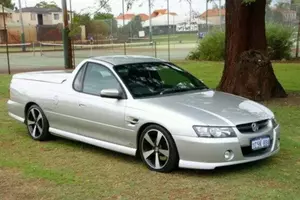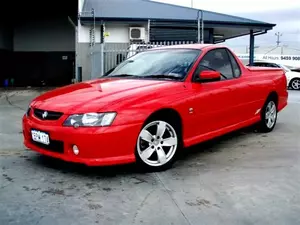
| Vehicle | Curb weight | Difference from world's smallest | Weight to power ratio | 0—60 mph acceleration ratio | Consumption ratio |
|---|---|---|---|---|---|
| 3.6 V6 |
1735 kg / 3826 lbs |
1310 kg (2889 lbs) heavier | 7 kg to 1 hp | - |
152 kg/L (335 lbs/L) |
| 6.0 V8 |
1786 kg / 3938 lbs |
1361 kg (3001 lbs) heavier | 5 kg to 1 hp | - |
123 kg/L (271 lbs/L) |
| Omega 3.6 V6 |
1711 kg / 3773 lbs |
1286 kg (2836 lbs) heavier | 6 kg to 1 hp | - |
150 kg/L (331 lbs/L) |
| Vehicle | 3.6 V6 |
|---|---|
| Curb weight |
1735 kg / 3826 lbs |
| Difference from world's smallest | 1310 kg (1310 lbs) heavier |
| Weight to power ratio | 7 kg to 1 hp |
| 0—60 mph acceleration ratio | - |
| Consumption ratio |
152 kg/L (335 lbs/L) |
| Vehicle | 6.0 V8 |
| Curb weight |
1786 kg / 3938 lbs |
| Difference from world's smallest | 1361 kg (1361 lbs) heavier |
| Weight to power ratio | 5 kg to 1 hp |
| 0—60 mph acceleration ratio | - |
| Consumption ratio |
123 kg/L (271 lbs/L) |
| Vehicle | Omega 3.6 V6 |
| Curb weight |
1711 kg / 3773 lbs |
| Difference from world's smallest | 1286 kg (1286 lbs) heavier |
| Weight to power ratio | 6 kg to 1 hp |
| 0—60 mph acceleration ratio | - |
| Consumption ratio |
150 kg/L (331 lbs/L) |

| Vehicle | Curb weight | Difference from world's smallest | Weight to power ratio | 0—60 mph acceleration ratio | Consumption ratio |
|---|---|---|---|---|---|
| 3.6 V6 |
1535 kg / 3385 lbs |
1110 kg (2448 lbs) heavier | 6 kg to 1 hp | - | - |
| Vehicle | 3.6 V6 |
|---|---|
| Curb weight |
1535 kg / 3385 lbs |
| Difference from world's smallest | 1110 kg (1110 lbs) heavier |
| Weight to power ratio | 6 kg to 1 hp |
| 0—60 mph acceleration ratio | - |
| Consumption ratio | - |

| Vehicle | Curb weight | Difference from world's smallest | Weight to power ratio | 0—60 mph acceleration ratio | Consumption ratio |
|---|---|---|---|---|---|
| 3.8i V6 |
1450 kg / 3197 lbs |
1025 kg (2260 lbs) heavier | 7 kg to 1 hp | 169 kg/s (373 lbs/s) | - |
| 3.8 i V6 S |
1450 kg / 3197 lbs |
1025 kg (2260 lbs) heavier | 6 kg to 1 hp | 175 kg/s (386 lbs/s) | - |
| 5.0 i V8 32V VR-6 |
1450 kg / 3197 lbs |
1025 kg (2260 lbs) heavier | 5 kg to 1 hp | - | - |
| 5.0 i V8 HSV |
1450 kg / 3197 lbs |
1025 kg (2260 lbs) heavier | 6 kg to 1 hp | 169 kg/s (373 lbs/s) | - |
| Vehicle | 3.8i V6 |
|---|---|
| Curb weight |
1450 kg / 3197 lbs |
| Difference from world's smallest | 1025 kg (1025 lbs) heavier |
| Weight to power ratio | 7 kg to 1 hp |
| 0—60 mph acceleration ratio | 169 kg/s (373 lbs/s) |
| Consumption ratio | - |
| Vehicle | 3.8 i V6 S |
| Curb weight |
1450 kg / 3197 lbs |
| Difference from world's smallest | 1025 kg (1025 lbs) heavier |
| Weight to power ratio | 6 kg to 1 hp |
| 0—60 mph acceleration ratio | 175 kg/s (386 lbs/s) |
| Consumption ratio | - |
| Vehicle | 5.0 i V8 32V VR-6 |
| Curb weight |
1450 kg / 3197 lbs |
| Difference from world's smallest | 1025 kg (1025 lbs) heavier |
| Weight to power ratio | 5 kg to 1 hp |
| 0—60 mph acceleration ratio | - |
| Consumption ratio | - |
| Vehicle | 5.0 i V8 HSV |
| Curb weight |
1450 kg / 3197 lbs |
| Difference from world's smallest | 1025 kg (1025 lbs) heavier |
| Weight to power ratio | 6 kg to 1 hp |
| 0—60 mph acceleration ratio | 169 kg/s (373 lbs/s) |
| Consumption ratio | - |